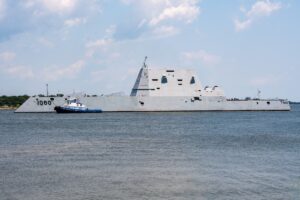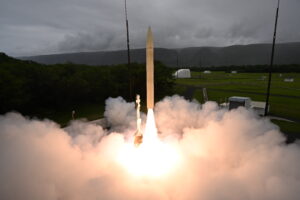Testing the first hypersonic missiles on the USS Zumwalt (DDG-1000) destroyer is running at least two years behind plan for 2025, pushed back to 2027, a Navy official said Thursday.
“So Zumwalt, we’re trying to figure out as that platform comes out of her build yard maintenance period and we start to look at what is all the final testing we’re going to have to do on our side, with our system, the testing is continuing, but… ‘25 is not a date that’s going to happen. So we’re just still trying to figure out where all that is going to match up, and when are we going to get that out there. But all the testing is continuing to move forward, and it’s going pretty well right now,” Vice Adm. Johnny Wolfe, Director of Strategic Systems Programs (SSP), told reporters during the Naval Submarine League’s annual symposium in Arlington, Va.

SSP is the Navy program manager for Conventional Prompt Strike (CPS), the Navy version of the shared hypersonic weapon with the Army. The two services are working together to design and develop the common All-Up Round of a Common Hypersonic Glide Body, missile body and rocket booster to be launched from different platforms.
Wolfe confirmed testing of CPS weapons on DDG-1000 is now expected to start further out in 2027-2028, primarily due to weapon testing running behind schedule.
In June, the Army and Navy said they completed a milestone flight test of the hypersonic weapon after several tests were canceled in 2023 (Defense Daily, July 2).
The Army was originally due to first field the hypersonic weapon by the end of 2023, but the test delays pushed that back to next year. A June Government Accountability Office report projected the Army will not field its hypersonic weapon battery until fiscal year 2025 in more recent test and production plans (Defense Daily, June 18).
The Navy previously planned to start testing CPS on Zumwalt-class destroyers by fiscal year 2025, replacing the unused Advanced Gun System with four CPS-capable 87-inch large diameter missile tubes that can carry three missiles each, for 12 total per ship. The service plans to ultimately deploy CPS on all three Zumwalt-class ships before adding them to the new Virginia-class attack submarines with the Virginia Payload Module (VPM). Deploying CPS to VPM was also previously planned to be ready by fiscal year 2029 (Defense Daily, Feb. 3, 2023).
Wolfe said his program is proceeding well to focus on making CPS ready to test on the Zumwalt despite the overall missile testing delays and additional delays in the destroyer’s maintenance period upgrading the ship.
“So the testing that we need to do to get to the final integration of Zumwalt – that’s irrespective of where the Zumwalt is at, whether it’s in the water because the way we’ve modularized this, the work that’s being done on Zumwalt is to get the tubes, the big, large diameter tubes in the platform – because of the way we’ve designed Conventional Prompt Strike to be modular.”
During the 2022 symposium, Wolfe said the biggest challenge in deploying hypersonic weapons on naval vessels was getting the weapon through its current all-up round integration by 2025 (Defense Daily, Nov. 8, 2022)
The Navy awarded HII a $155 million modification last year for the current DDG-1000 modernization period to install the CPS-capable missile tubes, following previous contracts that planned the modernization and procured long-lead time materials. The award expected an 18-month drydock availability to change the weapon system as well as perform other maintenance and modernization work, with work planned to be finished by September 2025. (Defense Daily, Aug. 30, 2023).
The USS Zumwalt first arrived at Ingalls Shipbuilding in August 2023. Wolfe now confirmed DDG-1000 is not due to leave HII’s [HII] Ingalls Shipbuilding facility in Pascagoula, Miss., for about another year.
Under the previous schedule before the missile testing delays, the Navy had scheduled the first two to three CPS test shots off DDG-1000 by December 2025.

Despite these delays, Wolfe said his program is currently testing and building the payload module adapter that goes into the missile tubes, so that will be ready once the shipyard work is finished. He also noted the Navy has built a facility to test the eject system since the missile has to be ejected from the tubes before launch.
“So all of that is continuing on. What we’re talking about is the final integration of when the weapon system, you know, proofing and developments, all done to the time I get it on the Zumwalt and I get the Zumwalt through her final testing, which is the graduation exercise where we actually launch a weapon out of Zumwalt,” he said.
While Wolfe is not responsible for the DDG-1000 and its maintenance period, he reported the conversion and maintenance work has gone very well despite overall delays. He argued the main limitation on CPS progress has been budget limits and progress on testing the hypersonic glide body with the Army, not delays in getting the ship out of drydock.
“It’s not going to be the limiter of the platform at this point. [The limiter] really is finishing all the testing, and a lot of that is in relation to how we’ve done testing with the Army as well. To get their testing completed, followed on by our testing. And so it’s just a matter of the way we were resourced. We were very limited on the assets that we had to be able to test,” he said.
Wolfe said this means whenever there is a hiccup in the hypersonic weapon testing regime, it stops everything in the testing line because they do not have enough assets allocated to the effort to proceed to the next test.
“You got to recycle and do all those things. So it’s that build up, which is what we’re experiencing right now.”
He insisted these delays should not impact installing the hypersonic weapons on VPM-equipped Virginia-class submarines.
That timeline will largely be up to when the submarines are deployed, if pushed back past the originally scheduled FY 2029 for CPS emplacement.
“The question is going to be, when will the first Virginia-class with the Virginia Payload Module be ready to go,” then they can start putting the capacity in it.